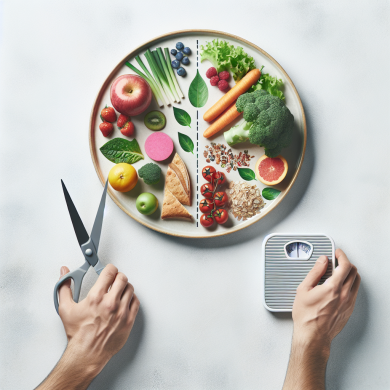Master Calorie Tracking: Tips for Success
Introduction
In the world of health and fitness, mastering calorie tracking can be a transformative tool for achieving your dietary goals. Whether you’re aiming to lose weight, maintain your current weight, or even gain some muscle, understanding the calories you consume and expend is crucial. This article will delve into the nuances of calorie tracking, offering practical tips and insights to help you succeed.
Understanding Calorie Basics
Before diving into the specifics of calorie tracking, it’s essential to understand what calories are. A calorie is a unit of energy. In the context of nutrition, it refers to the energy we get from the food and drinks we consume. Our bodies need calories to perform essential functions such as breathing, circulating blood, and physical activity.
The number of calories you need daily depends on various factors, including your age, gender, weight, height, and activity level. The concept of calorie balance is fundamental: to maintain weight, you need to consume roughly the same number of calories as you burn. To lose weight, you need to consume fewer calories than you burn, and to gain weight, you need to consume more.
Benefits of Calorie Tracking
Calorie tracking offers numerous benefits that extend beyond just monitoring your intake. Here are some key advantages:
-
Awareness: Tracking calories can increase your awareness of what you are eating and drinking. It helps you understand portion sizes and how different foods contribute to your overall intake.
-
Accountability: When you track your calories, you hold yourself accountable for your dietary choices, which can be motivational in sticking to your goals.
-
Data-Driven Decisions: With calorie tracking, you can make informed decisions about your diet. You can identify patterns, recognize problem areas, and adjust your eating habits accordingly.
-
Goal Setting: Whether you aim to gain, lose, or maintain weight, tracking calories can help set realistic goals and provide a clear path to achieving them.
Choosing the Right Tools
With the rise of technology, there are numerous tools available to help you track calories more efficiently. Choosing the right one can make a significant difference in your success.
Mobile Apps
Several smartphone apps are designed to make calorie tracking easy and convenient. Popular options include MyFitnessPal, Lose It!, and Cronometer. These apps typically offer extensive food databases, barcode scanners for easy entry, and the ability to track exercise and water intake.
Wearable Devices
Devices like Fitbit, Garmin, and Apple Watch can help track calories burned through physical activity. They sync with mobile apps to provide a comprehensive view of your energy balance.
Manual Tracking
For those who prefer a more hands-on approach, traditional methods like keeping a food journal or using spreadsheets can work effectively. This method may require more effort but can be customized to fit your needs precisely.
Tips for Accurate Calorie Tracking
Accuracy is crucial for effective calorie tracking. Here are some tips to ensure you’re getting the most precise data:
Measure Portions
Invest in a kitchen scale and measuring cups to accurately gauge portion sizes. Eyeballing portion sizes can lead to underestimating calories, particularly with calorie-dense foods.
Read Labels
Pay attention to nutrition labels on packaged foods. Note the serving size and calories per serving, as this information is vital for accurate tracking.
Track Everything
Record all calories consumed, including those from drinks, condiments, and small snacks. These can add up and make a significant impact on your daily intake.
Be Honest
Honesty is essential when tracking calories. It can be tempting to skip logging a small treat or indulgence, but this can skew your data and hinder your progress.
Adjust for Accuracy
Occasionally, reassess your calorie needs based on changes in weight, activity level, or goals. Your initial estimates may need adjustments to remain effective.
Overcoming Common Challenges
Calorie tracking can present challenges, especially when you’re starting. Here are some common issues and how to tackle them:
Eating Out
Restaurants often don’t provide detailed nutritional information. In such cases, estimate the calories based on similar meals from your tracking app or use an online resource to make the best guess.
Time Constraints
If time is an issue, prepare meals in advance and use app features like saved meals or recipes to speed up the logging process.
Social Situations
Social gatherings can make calorie tracking challenging. In such cases, focus on portion control, opt for healthier options, and compensate with more accurate tracking on other days.
Staying Motivated
Staying motivated is key to long-term success with calorie tracking. Here are some strategies to keep your enthusiasm high:
Set Realistic Goals
Set achievable short-term and long-term goals to maintain motivation. Celebrating small victories can provide the encouragement needed to continue.
Build a Support System
Engage with friends, family, or online communities that share your goals. Sharing experiences and challenges can provide support and accountability.
Mix It Up
Avoid monotony by exploring new recipes, trying different foods, or varying your exercise routine. Keeping things fresh can maintain your interest and prevent burnout.
Conclusion
Mastering calorie tracking is a powerful skill that can significantly impact your health and fitness journey. By understanding the basics, choosing the right tools, and implementing accurate tracking methods, you can make informed dietary choices that align with your goals. Overcoming challenges and maintaining motivation are essential components of long-term success. With dedication and a strategic approach, calorie tracking can become an invaluable part of your lifestyle, empowering you to achieve your desired outcomes and improve your overall well-being.














Add comment